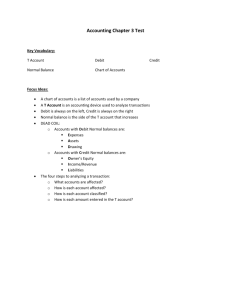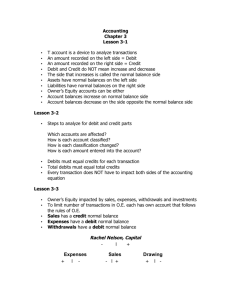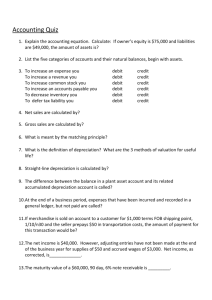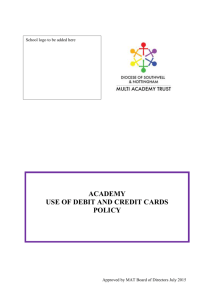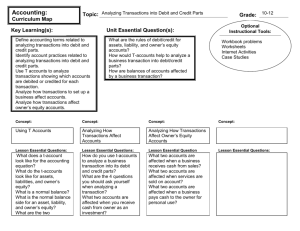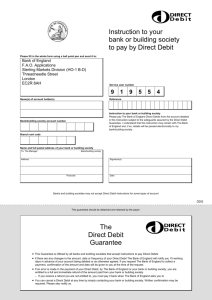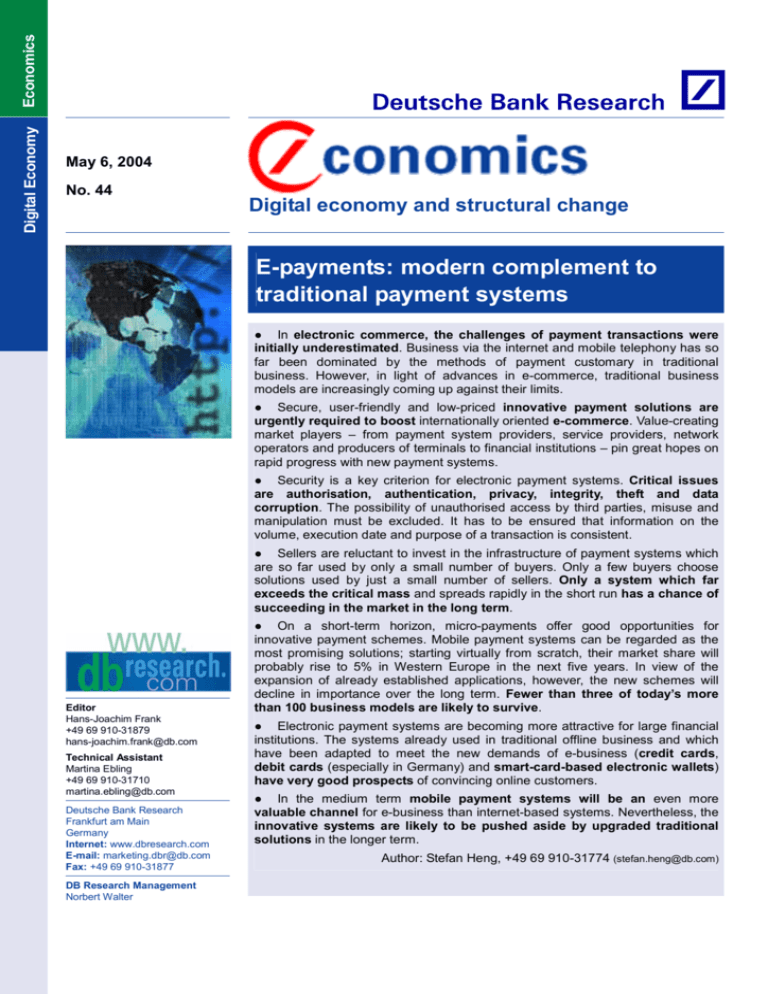
Economics
Digital Economy
May 6, 2004
No. 44
e-conomics
Digital economy and structural change
E-payments: modern complement to
traditional payment systems
& In electronic commerce, the challenges of payment transactions were
initially underestimated. Business via the internet and mobile telephony has so
far been dominated by the methods of payment customary in traditional
business. However, in light of advances in e-commerce, traditional business
models are increasingly coming up against their limits.
& Secure, user-friendly and low-priced innovative payment solutions are
urgently required to boost internationally oriented e-commerce. Value-creating
market players – from payment system providers, service providers, network
operators and producers of terminals to financial institutions – pin great hopes on
rapid progress with new payment systems.
& Security is a key criterion for electronic payment systems. Critical issues
are authorisation, authentication, privacy, integrity, theft and data
corruption. The possibility of unauthorised access by third parties, misuse and
manipulation must be excluded. It has to be ensured that information on the
volume, execution date and purpose of a transaction is consistent.
& Sellers are reluctant to invest in the infrastructure of payment systems which
are so far used by only a small number of buyers. Only a few buyers choose
solutions used by just a small number of sellers. Only a system which far
exceeds the critical mass and spreads rapidly in the short run has a chance of
succeeding in the market in the long term.
Editor
Hans-Joachim Frank
+49 69 910-31879
hans-joachim.frank@db.com
Technical Assistant
Martina Ebling
+49 69 910-31710
martina.ebling@db.com
Deutsche Bank Research
Frankfurt am Main
Germany
Internet: www.dbresearch.com
E-mail: marketing.dbr@db.com
Fax: +49 69 910-31877
DB Research Management
Norbert Walter
& On a short-term horizon, micro-payments offer good opportunities for
innovative payment schemes. Mobile payment systems can be regarded as the
most promising solutions; starting virtually from scratch, their market share will
probably rise to 5% in Western Europe in the next five years. In view of the
expansion of already established applications, however, the new schemes will
decline in importance over the long term. Fewer than three of today’s more
than 100 business models are likely to survive.
& Electronic payment systems are becoming more attractive for large financial
institutions. The systems already used in traditional offline business and which
have been adapted to meet the new demands of e-business (credit cards,
debit cards (especially in Germany) and smart-card-based electronic wallets)
have very good prospects of convincing online customers.
& In the medium term mobile payment systems will be an even more
valuable channel for e-business than internet-based systems. Nevertheless, the
innovative systems are likely to be pushed aside by upgraded traditional
solutions in the longer term.
Author: Stefan Heng, +49 69 910-31774 (stefan.heng@db.com)
May 6, 2004
E-payments: modern complement to
traditional payment systems
During the period of internet hype, leading private research institutes
were predicting that e-business turnover would more than double
annually up to 2005. But these exorbitant expectations were
disappointed, as volumes developed at a far more moderate pace.
One reason was that e-business pioneers tended to see product
range, marketing and logistics as the likely problem areas, and
initially underestimated the challenge of conducting downstream
payment transactions. Accordingly, the 35 m online purchases
already made in Europe have been dominated by payment methods
also customary in offline business (credit cards, debit cards, direct
debit, cash on delivery, invoicing, cash before delivery).
Nonetheless, there is general agreement that traditional business
models are increasingly coming up against their limits. If electronic
media are to be used in cross-border trade, then secure, userfriendly and low-priced innovative payment solutions must be
established very soon. While these online-enabled systems could
emerge from solutions in use today in offline business, they could
also develop from innovations tailored for e-business requirements.
We will begin by focusing on the general characteristics of payment
methods, and will discuss these considering systems currently in
use as examples. This is followed by an examination of the
demands which involved parties place upon payment systems. By
comparing system characteristics with system demands, we can
1
assess the prospects for electronic methods of payment.
20
18
16
14
12
10
8
6
4
2
0
120
%
EUR bn
100
80
60
40
20
0
99
00
01
02 03 04
05
06
M-payment transactions (EUR) (right)
Online payment transactions (EUR)
(right)
M-payment transactions as % of total
(left)
Source: Frost&Sullivan, 2002
Consumers' preferred internet
payment methods*, 2003
Symbiosis developing in online trade
Acceptance of electronic payment systems rises sharply when
associated with sales of purely digitised content. But mobile phone
or internet users will only accept paid content if it offers them real
value-added. According to the Association of German Magazine
Publishers (VDZ), 51% of internet users are basically prepared to
pay for content, especially database access and adult multimedia
products. Thanks to rapid transmission technologies like 3G and
WLAN, mobile telephony is becoming an important business area,
2
which is likely to achieve worldwide turnover of EUR 11 bn in 2005.
As early as 2001, European consumers spent some EUR 600 m on
mobile content like ringtones and logos, and EUR 250 m on internet
content. Sales of paid content will see a significant increase – e.g. in
Germany, sales are set to rise tenfold between 2002 and 2005.
Currently, the transaction costs associated with collecting micropayments (under EUR 10) which are charged for multimedia content
are only recoverable using the micro-payment system, not credit
cards. In view of the commissions and chargeback fees, the Stiftung
Warentest consumer testing agency calculates that settling an
account by credit card in Germany is only profitable for amounts
from EUR 1.50 upward. This is one reason why customers of the
Frankfurter Allgemeine Zeitung’s online archive pay EUR 1.50 per
article by electronic settlement, while a minimum amount of EUR 4
is set for credit card payment. Operators of innovative electronic
payment systems are very interested in cooperating with high-profile
1
For a discussion of the implications for monetary policy see Kern, Steffen (2001):
Electronic money – the payment instrument of the future? in: Deutsche Bank
Research, E-conomics, No. 12, Frankfurt a. M.
2
Heng, Stefan (2003): Mobile telephony – cooperation and value-added are key to
further success, in: Deutsche Bank Research, E-conomics, No. 42, Frankfurt a. M.
2
Mobile compared to online
payment expenditure, Europe
Economics
Invoice
34
Direct debit (paperbound)
32
Credit card
29
Cash before delivery
24
Cash on delivery
19
Online direct debit
19
10
Collection systems
M-payment systems
4
0
10
* in %, multiple answers possible
%
20
Source: Institute for Economic Policy and Economic
Research, Karlsruhe University, 2003
30
May 6, 2004
content providers. They hope to boost their reputation and, in this
way, win new customers.
Payment instruments: an overview
Payment instruments
Money
Cash
Banknotes
Coins
Scriptural money
Overnight
deposits with
central
banks
Sight
deps.
with
commercial
banks
Money substitutes
E-money
Network
money
Cheque
Bill of exchange
Credit card
Cardbased
money
Source: Schiebeck, Hölscher, 1998
Payment systems need a successful launch
Demand for a network good
Sellers are hesitant about investing in an electronic payment
infrastructure that only a few customers are, as yet, interested in
using. At the same time, few buyers will opt for a system used by
only a few merchants. This applies even to buyers who are normally
very open to new technologies. Established payment systems –
here we mean credit and debit cards, rather than invoicing or cash
on delivery – have an advantage over innovative electronic payment
systems as they are network goods which enjoy universal
acceptance. A system’s attractiveness rises proportionally faster
3
than the number of people using it. Only a product that far exceeds
the critical mass, and is thus able to spread rapidly in the short term,
has a chance of establishing itself in the market in the long term.
One route toward this end is offered by two platforms that represent
the entire value chain: Mobile Electronic Transactions (MeT) and the
E-Commerce Expert Group (ECOMEG). It is crucial that telecommunications companies, content providers, and established
banks in particular all play their part here. Financial institutions
represent constancy and so have a head start in winning customer
confidence, which aids the launch of any system.
Spectrum of demands: squaring the circle
In order to establish a system of payment, its access and security
technology has to offer solutions acceptable to all providers and
users. This means demands on the system could diverge widely – or
even contradict each other. For instance, the consumer has an
interest in being able to cancel transactions. However, financial
institutions and merchants want to rule this out as far as possible, in
view of high chargeback fees and the chance that bad debts might
arise.
Utility
Market
expands
Critical
mass
Market shrinks
Market size
Core criteria of preferred payment
methods*
66
User-friendly
Widely
available
56
40
Low effort
27
Low cost
Simple to
cancel
transactions
%
16
0
20
40
60
* in %, multiple answers possible
3
The telephone as a network good clearly illustrates this effect: The more people own
telephones, the more attractive it becomes for other individuals to acquire telephones,
so they can receive and make calls.
Economics
Source: Institute for Economic Policy and Economic
Research, 2003
3
May 6, 2004
Moreover, merchants are always interested in customer profiling.
This is the only way they can direct their marketing efforts with
pinpoint accuracy. Despite security mechanisms, German customers
in particular are very reluctant to divulge personal details on the
internet. Only one in four consumers is prepared to give confidential
data. Three out of five have never made an electronic purchase
because of fear of data misuse in the anonymity of the internet.
Payment transaction system
Payment system
The internet, as an open system, faces particular challenges when
dealing with sensitive data. Security is a central criterion for
electronic payment systems. In the foreground come questions of
authorisation, authentication, privacy, integrity and data corruption.
The possibility of unauthorised access by third parties, misuse and
manipulation must be excluded. To avoid disputes over payment, it
has to be ensured that consistency about the volume, execution
date and purpose of a transaction is guaranteed.
Institute 1
Issuer
Customer 1
Cardholder
Institute 2
Acquirer
Customer 2
Merchant
Perceived security – the crucial factor!
(Perceived) security plays a crucial role. It is derived from, among
other things, the level of security provided by the technology,
together with how it is marketed. If the system can offer acceptable
answers on issues of authorisation, authentication, privacy, integrity,
procedure if value units are stolen, and procedures to deal with error
transactions, then a high level of technological security will be the
result. Authorisation means that legitimate users really are the only
people who can use the system. Linked to this is authentication.
This means ensuring that the partners to the transaction really are
who they claim to be. The privacy criterion is fulfilled when the
system allows only the actual participants to observe the
transaction. Related to this is integrity. This is about protecting the
information transmitted from being manipulated for unlawful
purposes. In addition, procedures should be established for dealing
with a reported theft of any carrier medium (e.g. laptop) upon which
value units have been stored. Furthermore, electronic payment
systems must be prepared for the possibility of accidental data
corruption. It must be guaranteed that if a technical defect occurs,
the transaction will not be completed from either side (totality). The
customers need to know for sure that the agreed payment will reach
the intended recipients, and that only successful transactions will be
charged to their account.
Debit dates of various payment methods
Interest loss
Date due
Pre-paid
Interest gain
t
Post-paid
• Debit card
• Credit card
• Pre-paid e-money
units on smart
card or as
network money
• Direct debit
• GeldKarte
Source: DB Research, 2004
User-friendly access opens doors
Apart from security, of course, access conditions are also crucial to
winning acceptance. Fundamental to these are convenience and
4
Economics
Source: Ketterer, Stroborn, 2002
Demands on e-payment systems
General
&
Security
&
Consistency
&
Totality
Special demands of customers
&
Ease of use
&
Anonymity
&
Low cost
&
Portability
&
Widespread use among merchants
Special demands of merchants
&
Indisputability
&
Low transaction costs
&
Widespread use among customers
May 6, 2004
ease of use. Special hardware and software system requirements,
laborious registration processes, or menus that require long practice
to navigate successfully can all hinder acceptance of a procedure.
Special system requirements are a knockout criterion, purely
because quite a lot of online purchases are made at work using an
office computer to which the user has only limited administration
rights. Moreover, convenience depends on transmission speeds and
settlement procedures. The prospect of slow, unstable connections
impedes acceptance. Ultimately, convenience demands a system
that is flexible from a technological, economic and geographical
perspective. Solutions capable of conducting both online and offline
transactions, which can be used with different media (portability),
are solutions with healthy prospects.
21
25
%
20
17
14
15
11
10
5
0
Vision: the mobile phone replaces the wallet
2002
M-payment systems have a great advantage over internet-backed
services in terms of access conditions, in that they are used in both
online and offline transactions. Nevertheless, even m-payment
services are subject to limitations, as they are connected via mobile
phone, a medium unsuitable for higher-level security demands.
Payment is authenticated via text message (SMS) or automated
mobile call. Here, operators of mobile payment systems currently go
by the evidence of the “normal course of events”. In other words, the
owner of the mobile handset is invariably also presumed to be the
person who initiates the bank transaction. This principle is the
subject of legal debate.
In the following, we use prominent solutions in demonstrating how
these complex demands are applied in practice. Our comparison of
credit, debit and smart cards with new electronic methods points to
the market prospects of the innovative payment systems.
2003
2004
2005
Source: eMarketer, 2003
Sales of paid content, Germany
EUR m
127
140
120
100
86
80
60
45
40
14
20
0
Credit card in new robes even more attractive
2002
While the credit card, already in widespread use across the world,
has its origins in offline business, it is also gaining ground as a
method of making macro-payments in internationally oriented online
business. Some consumers, however, still shrink from making online
purchases by credit card. They fear that the card data needed to
make a payment (name, number, expiry date) could fall into the
wrong hands in the anonymity of the internet. This fear proves to
have few roots in objective reality, since except in cases of gross
negligence, the customer can claim compensation if his/her account
is debited in error. The risk of fraud is thus less of a burden on
cardholders than on merchants and credit-card companies.
4
Moreover, additional electronic functions like Verified by Visa make
credit-card use even safer and thus further promote its
attractiveness when making macro-payments.
2003
2004
2005
Source: Sapient, 2003
Credit card
Cost to the merchant: 3-5% of sales
Accepting outlets in Germany: 400,000
Users in Germany: 21 m
http://www.bdb.de
Source: DB Research, Dec. 2003
GeldKarte
Don’t write off the GeldKarte too soon
For micro-payments under EUR 10, using smart cards in online and
offline transactions offers more interesting fee structures than credit
cards. The smart card is available as an independent product, but
also in combination with a debit card. It stores encoded value units
on its chip. Because no information is transmitted other than the
monetary amount, this type of electronic wallet allows payments to
be made anonymously.
4
Demand for paid content, USA
(in % of internet users)
Cost to the merchant: 0.3% of sales, min.
EUR 0.01
Accepting outlets in Germany: 100,000 (7 of
which are online)
Cards issued in Germany: 62 m
http://www.geldkarte.de
Source: DB Research, Dec. 2003
The credit-card holder registers for Verified by Visa with the bank and receives a
password. When making an online purchase, the credit-card number is given over the
internet. After that, the password is submitted via the bank’s own website.
Economics
5
May 6, 2004
The smart-card-based electronic wallet is known as Proton in
Belgium, as Avant in Finland, as Danmont in Denmark, as Chipknip
in the Netherlands, as MEP in Portugal, as Minipay in Italy, as
Minicash in Luxembourg, as Moneo in France, as Monedero 4B in
Spain and as GeldKarte in Germany. The GeldKarte has so far
found only limited application in German e-business. To pay with this
card, the user needs a card-reading device with specialised
software. The card-reader costs EUR 60, a high price in relation to
the actual value-added it provides. This has hindered its broader
acceptance among private consumers to date. Accordingly, the 62 m
GeldKarte in circulation in Germany in 2002 were used in barely 36
m transactions in online and offline trade. By contrast, the 21 m
credit cards were used in 377 m transactions. Online suppliers offer
this as the reason for their cautiousness about the GeldKarte.
Another problem is that despite the high level of security
surrounding the GeldKarte, only seven online shops currently accept
it.
To limit the risk of losing the sum stored on the card, the German
GeldKarte, in contrast to France’s Moneo, does not provide an
automatic credit-reloading function. So credit can only be uploaded
at ATMs for the moment. In the future, though, a function for loading
credit via the internet is to be added, which will significantly increase
convenience and simultaneously guarantee a high level of security.
The GeldKarte is growing in attractiveness, not only because of its
increased user-friendliness, but also due to technological progress
and new legislation. Technological progress will bring a sustained
lowering of the price of the card-reading device required, which will
increase demand. In addition, a tightening of youth protection
legislation will provide a big boost to GeldKarte circulation from
2007. New regulations demand that those conducting online and
offline business differentiate between customers on the basis of age.
The GeldKarte thus offers an elegant opportunity to prevent younger
people from purchasing goods hazardous to youths, whether from
vending machines or on the internet.
Digital signature creates legal certainty
Transactions in m
400
50
350
300
250
40
Credit card
(left)
30
200
20
150
100
GeldKarte
(right)
50
10
0
0
1998
1999
2000
In view of the technological and legal aspects previously mentioned
(improved user-friendliness, fall in hardware prices, tightening of
youth protection legislation, digital signature law), once the current
lull passes, GeldKarte usage should make up significant ground in
the medium term, especially for micro-payments.
5
This reading device is the same one used with the GeldKarte.
6
See Lamberti, Hermann-Josef and Matthias Büger (2004): Elektronische Signaturen
machen etablierte Bezahlverfahren Internet-tauglich, in: Die Bank 3/2004, pp. 162164.
Economics
2001
2002
Source: Association of German Banks, 2003
Credit versus debit card, 2000
per 100 inhabitants
28
BE
118
20
DE
110
40
ES
109
58
65
FI
Credit card
Debit card
2
FR
55
76
78
GB
Germany’s Signature Law came in response to the new demands of
e-business, and places on an equal footing the digital signature
used on the internet and the handwritten signature used in
traditional business situations. The digital signature is stored on a
smart card and is used with the aid of a specialised card-reading
5
device. In this way, specialised security mechanisms largely protect
the actual identities of both partners to a contract. The signature
alliance formed in Germany among banks, businesses and
government bodies will continue to drive forward this project, which
6
is so crucial to electronic commerce.
6
Credit card versus GeldKarte ,
Germany
26
NL
127
29
EU 12
79
0
20
40
60
80 100 120 140
Source: European Central Bank, 2000
May 6, 2004
Click&buy makes its mark in micro-payments
Up to now, the internet-based Firstgate click&buy in particular has
worked very successfully in the area of micro-payments. Firstgate
click&buy aggregates payments and debits the total sum from the
buyer’s bank account. Payment via Firstgate click&buy is made by
inputting a user name and password. No personal data about the
buyer is available to the seller, nor is further information about the
actual transaction available to the system operator, which
guarantees anonymity.
Firstgate click&buy
Cost to the merchant: 10-35% of sales
Accepting outlets in Germany: 2,500
Users in Germany: 2 m
http://www.firstgate.de
Source: DB Research, Dec. 2003
Telephone collection a qualified success
Infin-MicroPayment operates through fixed-rate telephone service
lines and collects payment via the telephone bill. When customers
call the service line, they receive a transaction number (TAN) for the
intended payment. From the consumer’s point of view, the
advantage of telephone collection is that no personal data is
transmitted across the internet, thus guaranteeing anonymity. The
seller places particular value on the payment guarantee provided by
the system operator. The downside of infin-MicroPayment is that the
toll-paid service number (in Germany currently: 0190; in future: 0137
or 0900), when used for making micro-payments, attracts substantial
additional telephone charges on top of the actual price of the
purchase. Another disadvantage is that this procedure is suitable
only for micro-payments, but not for macro-payments, as German
law places an upper limit of EUR 30 on payments made through
service lines. The charging limits, additional costs and dial-in
procedure all cast doubt upon the ability of infin-MicroPayment to
survive into the medium to long term.
Infin-MicroPayment
Cost to the merchant : 15-35% of sales
Accepting outlets in Germany: < 50
Users in Germany: n.a.
http://www.infin-online.de
Source: DB Research, Dec. 2003
Moxmo: medium-term alternative
In contrast to internet-based payment methods like Firstgate
click&buy and infin-MicroPayment, Moxmo offers a mobile-phonebased method. To guarantee anonymity, Moxmo keeps transmission
of payment data separate from the actual ordering process.
Accordingly, during the payment process the buyer only gives the
seller a mobile phone number (or, in a procedure offering greater
anonymity, a specially assigned dummy number). The seller
forwards to Moxmo the instruction to pay. Moxmo calls the buyer,
verifies the relevant information (identity, amount), and collects the
amount owed through direct debit. The advantage of Moxmo is the
secure nature of the system, as sensitive data are never transmitted
via the internet. But the system has a weak point: the high security
levels guaranteed by the digital-signature method are not matched
by Moxmo’s underlying security procedures, which are based on
mobile-phone technology.
Moxmo
Cost to the merchant: 3% of sales
Accepting outlets in Germany: 10
Users in Germany: approx. 1 m
http://www.moxmo.de
Source: DB Research, Dec. 2003
M-payment system
1
Buyer
Merchant
5
Established systems still hold the advantage
2
3
Economic, technological and legal challenges are making it
increasingly obvious that solutions customary in traditional business
are coming up against their limits when faced with electronic
business transactions which take place in separate locations and at
different times. System providers must quickly come up with
convincing solutions suitable for the growing area of e-business.
However, the demands of consumers and merchants often diverge
widely, making this an extremely complex task.
Support from high-profile partners is crucial to the wider
dissemination of new payment systems. A solution’s success hinges
on the questions of user-friendliness and perceived security. Here,
content providers, suppliers of telecommunications infrastructure,
Economics
4 PIN,
€
M-payment
system
€
1 – 5: process sequence
: Order
: Delivery of goods
€ : Payment
: Inquiry by mobile phone
PIN: Personal identification number
Source: DB Research, 2004
7
May 6, 2004
and in particular banks, with their good reputation for conducting
monetary transactions, have a duty to help lay the foundations for a
successful launch. Suppliers of new products find it extremely
difficult to make their mark against systems already established in
the market. Small innovative system providers only have a real
chance in niche markets, where big market players currently regard
margins as insufficient. So the field of micro-payments will offer
limited opportunities for innovative systems over the next five years.
The task of proving the buyer’s identity on concluding a contract will
in future bring the current business model of many innovative
payment systems onto shaky ground. The mechanisms in current
use cannot offer the degree of indisputability guaranteed by the
digital signature. Although the mobile phone as everyday companion
essentially constitutes an interesting alternative, doubts on the legal
and technical sides will continue to restrict the long-term potential of
m-payment systems. But thanks to advances in new rapid mobilephone transmission technologies, mobile payment systems will
achieve notable success in the short term. Their share in the total
number of cashless transactions, which remains negligible in
Western Europe, should grow to more than 5% over the next five
years. After that, though, the figure will fall sharply and rapidly with
the assimilation of up-and-coming new systems. Accordingly,
consolidation is making massive strides in the still-young business
area of electronic payment systems. Network effects mean even
innovative payment systems that are fundamentally extremely userfriendly will be pushed out of the market. Fewer than three of today’s
more than 100 business models are likely to survive the next five
years. On the other hand, systems already successful in offline
business have excellent prospects. These include the internationally
established credit card and, especially in Germany, the widely used
debit card and smart card. The number of transactions made in
Germany using the GeldKarte should increase by a factor of ten
over the next five years.
Prospects for credit, debit and smart-card use in electronic
commerce are improving, thanks to the establishment of new
security mechanisms driven in Germany by the signature alliance. In
addition, the major banks should start to take an interest very soon
in micro-payments, currently a market niche. If payment systems
already established today are expanded through substantial
investments to meet the demands of e-business, they are likely to
win over online customers straight away.
Exemplary Iberian cooperation
There has been much talk recently about the
Spanish m-payment initiative Mobipay. This
business model was agreed upon by Spain’s
major
banks
and
telecommunications
companies. The number of accepting outlets is
about 54,000. Combining the different
customer bases would make about 80% of the
total Spanish population reachable.
As with Moxmo, the Mobipay customer gives
the seller a mobile phone number. To simplify
the procedure, this number can also be stuck
to the phone as a barcode and scanned at the
till. Once Mobipay receives notification, it
sends a text message. The customer confirms
this data using a personal identification number
(PIN). The speed of the transmission
technology means the entire transaction can
be concluded online within 15 seconds.
Cashless payment systems
Number of annual transactions per
inhabitant, 2002
BE
DE
ES
FR
LU
NL
EU 12
0
70
Bank transfer
Direct debit
Credit/debit card
Cheque
Card-based e-money
140
210
Source: European Central Bank, 2003
Author: Stefan Heng, +49 69 910-31774 (stefan.heng@db.com)
© 2004. Publisher: Deutsche Bank AG, DB Research, D-60272 Frankfurt am Main, Federal Republic of Germany, editor and publisher, all rights reserved. When
quoting please cite “Deutsche Bank Research“.
The information contained in this publication is derived from carefully selected public sources we believe are reasonable. We do not guarantee its accuracy or
completeness, and nothing in this report shall be construed to be a representation of such a guarantee. Any opinions expressed reflect the current judgement of
the author, and do not necessarily reflect the opinion of Deutsche Bank AG or any of its subsidiaries and affiliates. The opinions presented are subject to change
without notice. Neither Deutsche Bank AG nor its subsidiaries/affiliates accept any responsibility for liabilities arising from use of this document or its contents.
Deutsche Banc Alex Brown Inc. has accepted responsibility for the distribution of this report in the United States under applicable requirements. Deutsche Bank
AG London being regulated by the Securities and Futures Authority for the content of its investment banking business in the United Kingdom, and being a member
of the London Stock Exchange, has, as designated, accepted responsibility for the distribution of this report in the United Kingdom under applicable requirements.
Deutsche Bank AG, Sydney branch, has accepted responsibility for the distribution of this report in Australia under applicable requirements.
Printed by: HST Offsetdruck Schadt & Tetzlaff GbR, Dieburg.
ISSN Print: 1619-3245 / ISSN Internet: 1619-3253 / ISSN E-mail: 1619-4756

